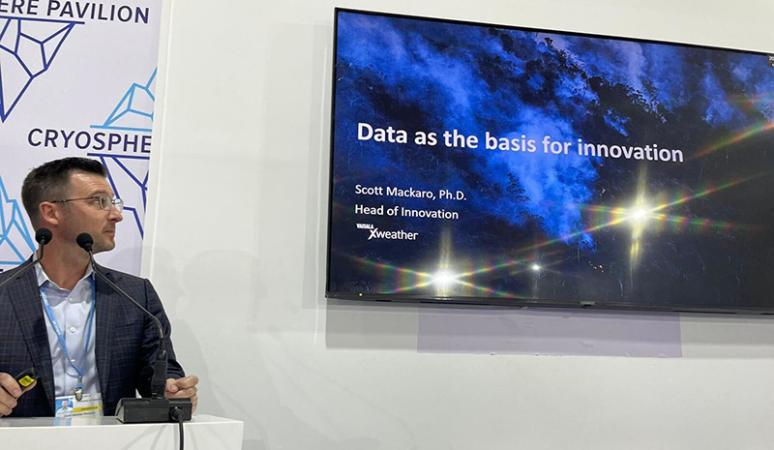Using data to innovate for the impacts of climate change – and six questions to ask before even starting
In response to the global climate crisis, many companies and organizations are at the forefront of sustainable development and innovation. But how to know where to focus? That’s where reliable data becomes crucial.
At the United Nation’s recent Climate Change Conference COP27 in Egypt, I had the opportunity to discuss the role of data for climate impact innovation – a topic close to the heart of Vaisala Xweather, as we aim to provide real-time and hyperlocal weather and environmental data to predict and solve challenges from lightning-triggered wildfires to weather-related car accidents.
What to consider when gathering and analyzing data
When dealing with weather and climate, tremendous amounts of data are generated. With data from multiple days, seasons, and years, you quickly find yourself dealing with a true big data problem. Many in the field of weather and climate will tell you that the environment is the first true big data challenge considering that petabyte scale datasets are commonplace.
One major lesson I’ve learned is that all data is not created equal. When attempting to address the impacts of climate change, or any weather-related challenge, you have to ask several questions. Here are six of the most crucial ones.
1. Can the data contain human bias?
Humanity has a bad habit of introducing own biases into data. A simple example is when we measure weather or climate conditions at airports and assume it represents the surrounding area. Airports tend to be clear of things like buildings, trees, and vegetation. This isn’t always the case in neighboring terrains. Thus, developing solutions based on the airport data only will have inherent biases.
2. Does the data represent the local environment?
Some data is always better than none, but if the closest data source is tens or hundreds of kilometers away (i.e. at a nearby airport), it may not be capturing the unique characteristics of the local environment.
3. Does it measure the characteristics of the problem you are trying to solve?
A great example is when you get data from the road vicinity, but not its surface. Measuring the air temperature doesn’t always offer as much insight to what is happening at the road surface as you might think.
4. Is the record length enough?
Weather can change drastically from one day, month, or season to the next. A season in one year may even differ greatly from the same season in the next year. Things like weather system intensity, long term weather patterns, and climate cycles like El Nino and La Nina can play a role. Building models that perform well year after year require long record lengths and measuring equipment that will stand up to the test of time.
5. How precise is the data?
There are many options for measuring weather conditions. Getting the same answer from two of the same sensors is a great way to ensure the data you are using is the right quality.
6. Are datasets and solutions generated in one part of the world extensible to another?
Developed nations have long standing and continuously improving observation networks. We have access to powerful computers and the means to deploy vast networks of Internet of Things sensors that communicate across strong cellular networks. Yet we often fail to ask if the solutions we develop based on these networks will work in less developed parts of the world.
Put data into use to solve key climate and environmental questions
At COP27, we discussed both what to consider when gathering and analyzing data as well as how to use data in an innovative way, illustrated through a few concrete examples.
Keeping up to heating demand when cold gets colder and warm even warmer
As climate change continues to result in colder cold-events and warmer warm-events, energy companies are challenged to keep up to demand. When minor changes in temperature, solar radiation, humidity, wind speed and direction affect the demand for heating energy, accurate weather data can create significant advantages for energy companies.
In Espoo, Finland, Vaisala’s customer Fortum optimized its district heating using a hyperlocal weather forecast with the highest accuracy. Combining six weather stations and Vaisala’s AI-powered Hyperlocal Weather Nowcasting, Fortum is now able to predict heating demand for the next 24-48 hours with higher reliability in the selected area.
Making more intelligent water use decisions
Irrigation plays a major role in global agriculture ranging from crops to residential lawns. With climate change and increasing severe weather events from droughts to flooding, the need to use water in an intelligent way is greater than ever.
A traditional approach to plan irrigation is to use climate normals based on a 30-year history from measurement locations with such record lengths. There are two challenges with this approach. First, climate normals based on 30-year histories are not always representative of what we are experiencing today and almost always do not match climate projections. Second, locations with lengthy record lengths tend to be far from the area of interest.
Vaisala Xweather addressed these challenges by developing a high-resolution dataset of climate normals that combines local observations and modeling capabilities. This dataset also leveraged a much shorter time period in creating its normal. This helps to better represent the local situation today and align more closely with climate projections.
Solving for climate impact
The impacts of climate change are being felt today, across the globe. High quality data is the basis for innovative approaches that address these impacts and support resiliency. While data is the basis for innovation, innovation can be the basis for data needs. This way the cycle continues.
Vaisala Xweather has a broad portfolio of datasets and solutions that can enable true hyperlocal weather forecasts where it matters most to you – and our climate. Visit us at www.xweather.com today to learn more.


Add new comment